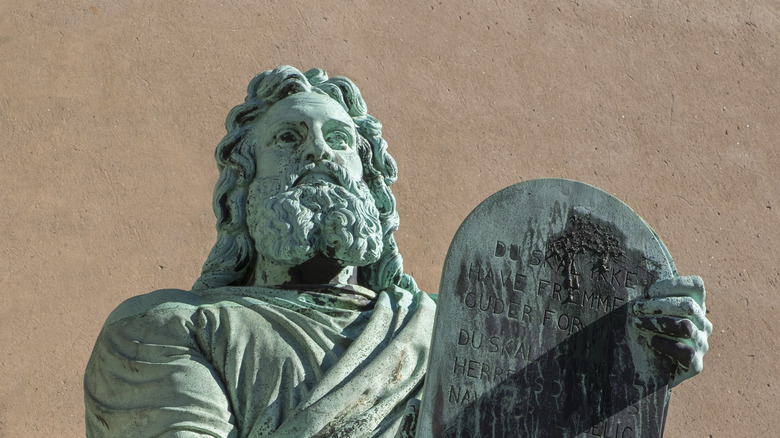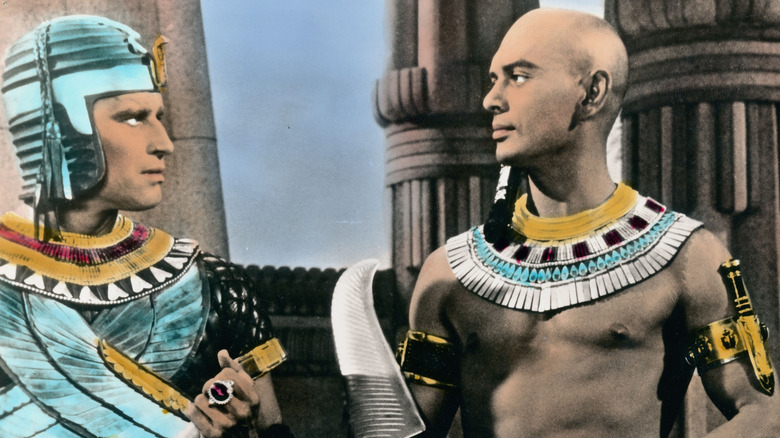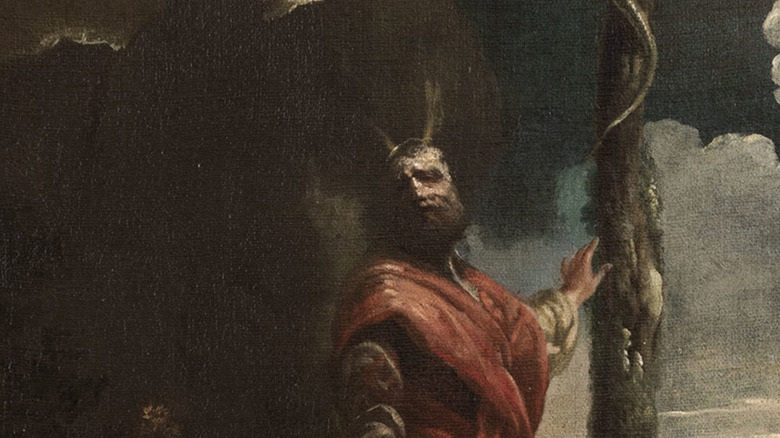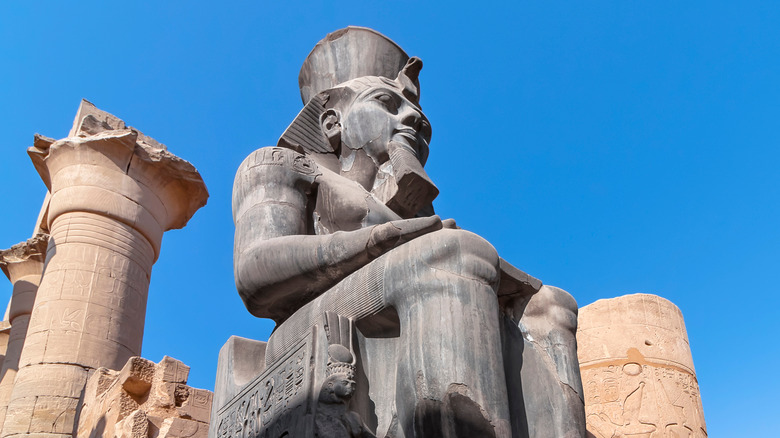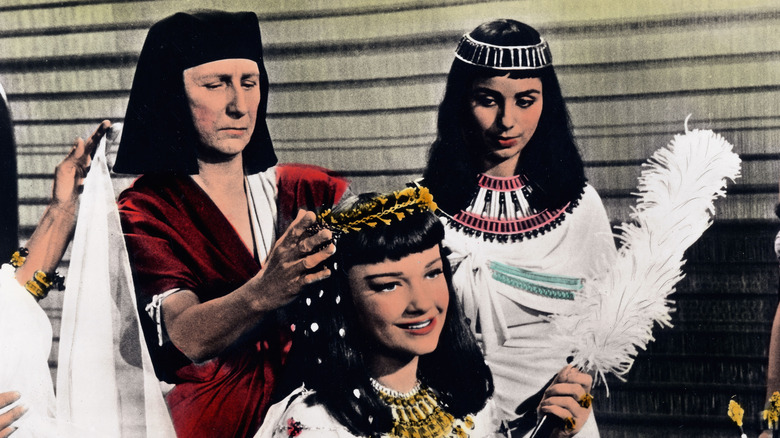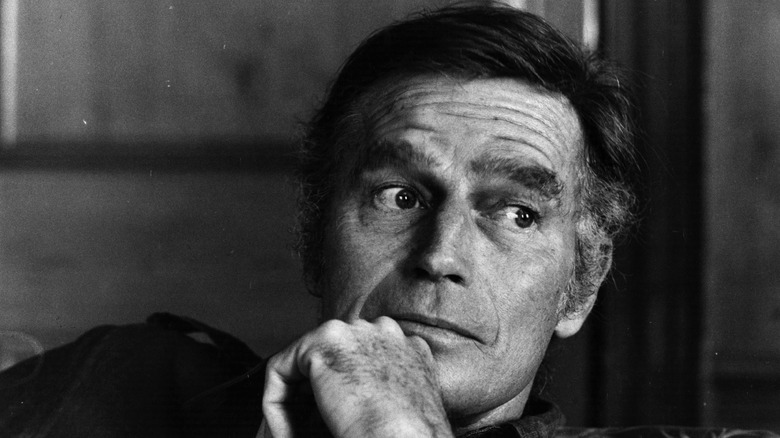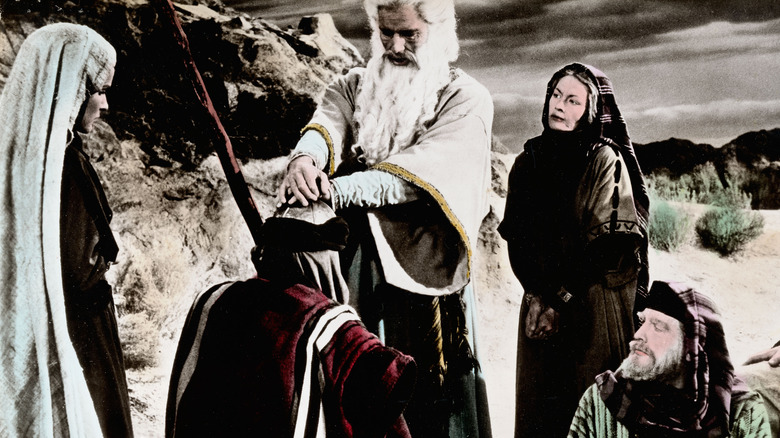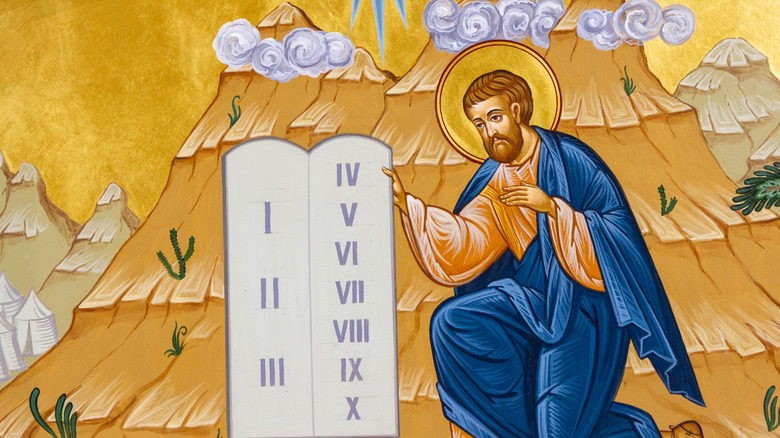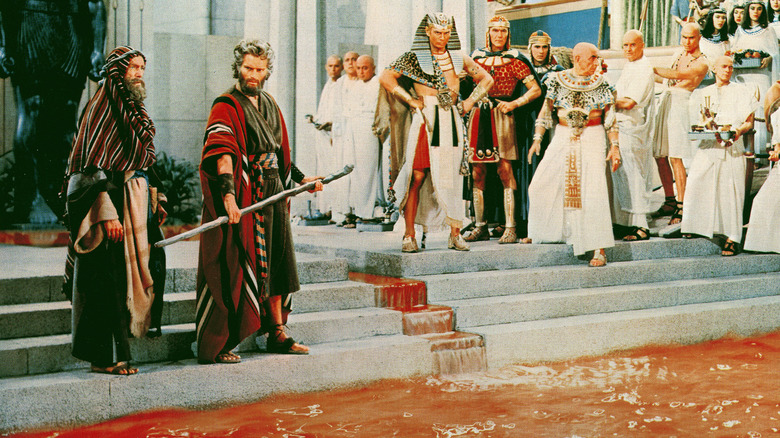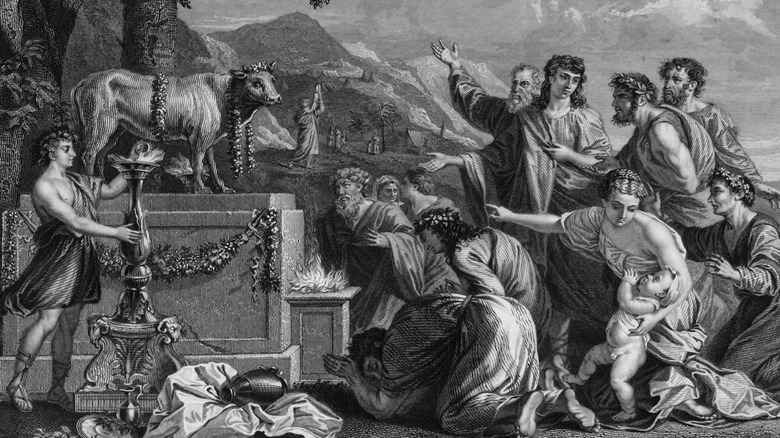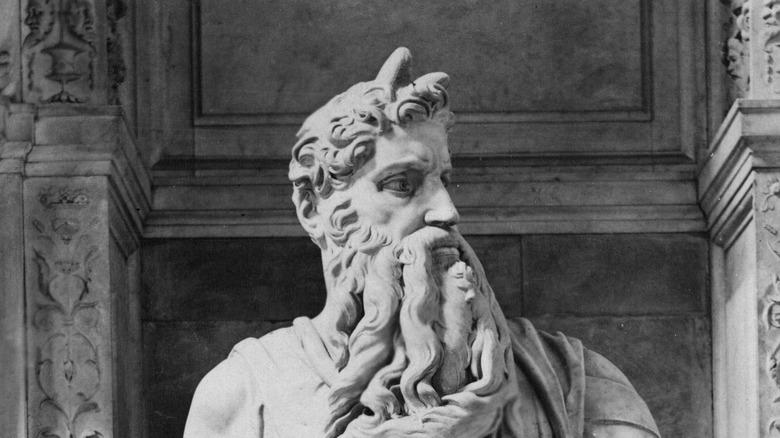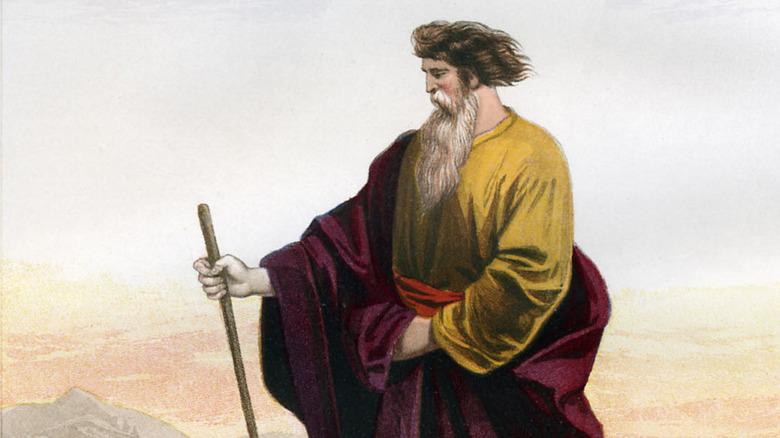Biggest Differences Between The Ten Commandments Movie And The Bible
The Biblical epic hasn't quite gone from American movie theaters. In the past 10 years, the likes of "Noah" and "Exodus: Gods and Kings" have come and gone. The former attracted generally favorable reviews (via Rotten Tomatoes); the latter, not so much. Neither, according to Variety, set the box office on fire.
But there was a time when a Bible film became the highest-grossing movie of 1956. Cecille B. DeMille's "The Ten Commandments" earned over $85 million in its initial release, according to The Numbers, over $900 million when adjusted for inflation. Beyond its financial success, the film left an indelible mark on American culture. From its depiction of the pharaohs who subjugated the Hebrews to Charlton Heston's Oscar-winning portrayal as Moses, "The Ten Commandments" shaped conceptions of the Book of Exodus in the modern age and continues to see references and parodies to this day.
Anyone looking to use the film as a true and honest guide to a pivotal text of the Old Testament, however, may want to turn elsewhere. DeMille himself admitted that "The Ten Commandments" wasn't a completely faithful adaptation of Exodus. The original beginning of the film saw DeMille stand before the audience and explain that his telling of the story of Moses was augmented by additional historic texts — with a few Hollywood touches here and there, though he left that unsaid. Here are some of the film's biggest departures from the Book of Exodus.
Moses the Conqueror
Charlton Heston first enters into "The Ten Commandments" as a Moses fresh from victory. Sent to wage war on Ethiopia, he returns to Egypt with word that he has made allies of his enemies and brought tribute to Sethi (Sir Cedric Hardwicke), pharaoh of Egypt and Moses' foster father. Such deeds win Sethi's admiration but feed the envy of Rameses (Yul Brynner), Pharaoh's son by blood.
None of this comes from the Bible, which leaps from the discovery of Moses in the basket to his killing of an Egyptian for the sake of a slave. But there are other ancient writings that spare more thought to his formative years. The Romano-Jewish historian Josephus examined Moses' time in Egypt throughout his "Antiquities." In Book II, Chapter 10, he describes how Ethiopia brought war to Egypt, and Moses was made a general to fight against them. His martial skill proved a match against his foes, but he brought an end to the war through marriage with the daughter of the king of the Ethiopians.
Josephus was one of the sources Cecil B. DeMille cited by name in the opening of "The Ten Commandments." The film only depicts the aftermath of Moses' war, however, and leaves out peace through the bridal bed. Just how Moses made friends of Ethiopia isn't explained, though a brief flirtation by the king's sister gives some nod to "Antiquities."
The Day of Moses
In "The Ten Commandments," after impressing Pharaoh with his victory in Ethiopia, Moses is tasked with building a treasure city. This brings him into close contact with the enslaved Hebrews for the first time. Upon seeing the conditions in which the slaves must work, Moses orders the granaries of the temples raided to feed them. He also institutes a day of rest. Later in the film, it is reported to Pharaoh that the slaves name this the "day of Moses."
In the Bible, Moses' first encounter with his people is when he slays an Egyptian mistreating a slave. But the story of his winning them a day of rest can be found in the Shemot Rabbah, a midrash of Exodus dated to A.D. 1200. A midrash, according to My Jewish Learning, is an interpretation of a Biblical text in rabbinic literature that investigates Biblical events and sometimes invents new stories to complement them and address contemporary issues.
The Shemot Rabbah 1:28 creates such a story when it sends Moses among his people to lighten their burdens while he is still counted as a son of Egypt. He redistributes labor according to ability and goes so far as to petition Pharaoh for a day of rest. "One who has a slave," he tells Pharaoh, "if he does not rest one day a week, he will die! While your slaves, if you don't allow them rest one day a week, they will die!"
The Name of the King
The Book of Exodus only refers to the kings of Egypt Moses encounters by the title Pharaoh. The first pharaoh mentioned in Exodus forgets the friendship his predecessors shared with Joseph and the Israelites, enslaves them, and orders their firstborn sons killed. It is this pharaoh's daughter who rescues Moses from the river, and it is his successor whom Moses contends with for the freedom of Israel.
"The Ten Commandments" gives names to the pharaohs of Exodus, including the pharaoh who orders the killing of the firstborn: Rameses I. After him comes Sethi, who raises his sister's adopted son Moses as his own alongside Rameses II. Sethi openly favors Moses until they fall out over the fate of the slaves. Even then, he proclaims his love for his foster son on his deathbed. This leaves Rameses II, played by Yul Brynner, as pharaoh when Moses returns to Egypt. Ruthless and jealous of Moses since their youth, Rameses is the primary antagonist of "The Ten Commandments."
According to National Geographic, the historical Rameses II is among the most popular candidates for the pharaoh of Exodus, and his immediate predecessors were Seti I and Rameses I.
Nefretiri
Anne Baxter received third billing in the opening credits of "The Ten Commandments" for her role as Nefretiri. She is the ward of Sethi, bound to marry whomever he names his successor as pharaoh of Egypt. Given the choices of Moses or Rameses as a husband, Nefretiri isn't shy about her favorite. She and Moses are already lovers, while there is no affection between her and Rameses. When she learns that Moses is Hebrew, Nefretiri goes so far as to kill the messenger to try and ensure his succession to the throne.
The truth eventually reaches Sethi's ears, and Moses is banished into the desert. There, he meets and marries Sephora (Zipporah in the Bible) and first encounters the Lord. When he returns to Egypt, it is as a changed man. He rejects Nefretiri's attempts to seduce him. For this rejection, it is Nefretiri who hardens Pharaoh's heart against the Israelites and, after the plague of the firstborn, urges Rameses to kill Moses.
Nefretiri isn't from the Bible. There is no Egyptian lover for Moses there, or any romance before Zipporah. There is no mention of Nefretiri or any equivalent figure in Josephus or Philo, the named historians Cecil B. DeMille relied on to expand the story. But the historical Rameses II's first and favored wife was Nefertari, according to Britannica.
Charlton Heston Didn't Lack For Eloquence
When Moses encounters the Lord through the burning bush in the Bible, he pleads not to be made God's messenger to Egypt. "I am not eloquent," he tells God in Exodus. "I am slow of speech and of tongue." God therefore instructs Moses to find his brother Aaron, who will serve as his oracle. It's an arrangement that endures through the first few plagues, though by the fourth plague in Exodus 8, Moses tends to speak for himself.
"The Ten Commandments" (via Movieclips) omits any mention of Aaron in the scene with the burning bush, and it omits Moses' estimation of his speaking abilities. While Aaron is still present when Moses comes to Pharaoh and demands his people be set free, Moses does most of the talking. The change may have been to better showcase Charlton Heston. According to The Washington Post, Heston was a classically trained actor who began on the stage, where projection and enunciation are necessities. Heston's own voice was one of his most distinguishing features as an actor, being noted in outlets like the Guardian at the time of his death in 2008.
A stage-trained actor with a notable voice may seem odd casting for a man meant to be slow of speech and tongue, but with everyone from Stephen Colbert to "The Simpsons" having referenced and parodied Heston's performance, it's hard to argue with results.
The Prominence of Joshua
One of the most prominent supporting characters in "The Ten Commandments" is Joshua, played by John Derek. Moses befriends him shortly after taking over construction of Pharaoh's city, being impressed by his courage and honesty. Joshua becomes the Hebrew Moses kills to save. The more devout of the two, at least in the beginning, Joshua names Moses the deliverer of Israel and later finds him in the desert to urge him back to Egypt. He becomes Moses' chief assistant in evacuating the Hebrews and his ultimate successor as their leader.
The Joshua of the Bible was also one of Moses' aides, named by God as Moses' successor as leader of the Israelites in Numbers 27. But he doesn't enter into the Bible by name until Exodus 17, well after the events that "The Ten Commandments" is based on. The Hebrew Moses saves from an Egyptian has no name, and the Hebrew who comes to Moses in the desert in Exodus is his brother Aaron.
The Bible also makes no mention of Lilia (Debra Paget), Joshua's love interest in "The Ten Commandments." The addition of characters like Lilia and Nefretiri, and Joshua's altercations with various Egyptians, left Cecil B. DeMille open to charges of throwing sex and violence over Bible stories. He responded to those criticisms in his autobiography (via The Guardian), wondering if said critics had ever read the Bible.
The Mountain of God
In both the Bible and "The Ten Commandments," Moses encounters God through the burning bush he finds on the slopes of Mount Sinai. The name given to the mountain in Exodus 3 is Horeb, but the majority of scholars consider this to be another name for Sinai, according to the Jewish Encyclopedia. If so, that would make it the same mountain where Moses later leads the Israelites to receive the Ten Commandments.
The chief difference between the Bible and the film is how Moses comes across the burning bush. The Bible only says that he was leading his flock of sheep through the wilderness when he noticed that the fire did not consume the bush and came to investigate. In "The Ten Commandments," Moses learns soon after arriving in the land of Midian of Mount Sinai's reputation as the mountain of God, forbidden to men and distinguished by a circle of clouds about its face that sometimes glows with fire.
Moses breaks the taboo of climbing the mountain after he discovers Joshua in the wilderness. In the midst of an argument, he spies the burning bush at a distance. Having remarked earlier in the film that he wishes to see God to know that he exists and why he has not delivered the Israelites from slavery, Moses elects to pursue the bush with a thought to its divine origin already in his mind.
Plagues on a Budget
One of the most famous episodes in all the Bible is the Plagues of Egypt, the 10 disasters called down upon the kingdom when Pharaoh refuses to free the Hebrew people. Heralded by Moses, God sends these wonders to demonstrate his power to all the earth. The 10 plagues, as per World History Encyclopedia, are the turning of the Nile to blood, frogs, gnats, flies, pestilence, boils, a storm of hail, locusts, "a darkness to be felt" (so described in Exodus 10) and, finally, the death of the firstborn sons of Egypt.
"The Ten Commandments" only depicts four plagues. They all receive a mention (via YouTube), but only the river of blood, burning hail, darkness, and death of the firstborn are shown on screen. With no digital technology available in the 1950s, such effects could only be achieved practically or through optical printing. These techniques are limited by time, money, and physics.
"Making Miracles," the documentary on the production of "The Ten Commandments," devotes a section to explaining how the plagues were done. It also explains why at least one plague was cut despite being shot. The plague of frogs was meant to be depicted by rubber animatronics rigged to leap about. The sequence was filmed, but Cecil B. DeMille judged the results unconvincing and took it out of the film.
It Pulled Korah Ahead in Time
Despite its title, most of "The Ten Commandments" is concerned with Moses' time in Egypt and the deliverance of the Hebrews from bondage. It's only near the end of the film that Moses ascends the mountain to receive God's law. Meanwhile, the Israelites are tempted by Dathan (Edward G. Robinson). Depicted as an overseer who informed on his own people to Rameses, Dathan constantly works against Moses. In his absence, Dathan compels Moses' brother Aaron to create a golden calf. He also recruits a man named Korah as high priest. When Moses returns with the Ten Commandments and beholds Dathan's idolatry, he throws the stone tablets upon the idol, opening the earth to swallow the blasphemers (via Movieclips).
There is a Dathan and a Korah in the Bible. However, their rebellion happened much later than Exodus. In the Book of Numbers, it is Korah who leads a band of Levites against Moses and Aaron, with Dathan among his following. There is no mention of Dathan having been an overseer or a spy, though the Jewish Encyclopedia notes that rabbinical literature connected him to events in Exodus.
The ending of Korah and Dathan's rebellion was brought forward in time with them. In Exodus 32, Moses destroys the golden calf and scatters its ashes into water that the Israelites are made to drink. Later, he commands the Levites to cut down 3,000 men. The earth opening to consume the rebels happens in Numbers.
No Horns For Moses
The signs and wonders that the Lord sends leave their mark upon Moses in the Bible. After destroying the first set of tablets bearing the Ten Commandments, he ascends Mount Sinai again with new set. After God descends and renews the commandments in Exodus 34, Moses returns to his people unaware that the experience has transformed him. According to The Torah, just what that transformation was is a question of interpretation. He has been variously described as having shining or glowing skin after the encounter or sprouting a pair of horns. Either way, his new appearance frightened the Israelites, and Moses took to wearing a veil except when speaking to the Lord.
"The Ten Commandments" includes one line of dialogue about Moses shining with the light of God, but there is no glow, shine, or horns on Charlton Heston's face in this or any other scene. The only change to his appearance is in the color of his hair and beard, which go from gray to white. This is an extension of a scene earlier in the film where, after encountering the burning bush, Moses' hair grows and becomes streaked with gray (via YouTube). Perhaps this was considered a less difficult way of conveying the same idea as the shine or the horns.
The Last Words of Moses
For all his efforts to lead the Israelites to the Promised Land, Moses does not enter it. Having disobeyed God during the years of wandering in the desert, he is allowed to see the land from Mount Nebo. Before ascending the mountain, Moses gives a final word to the people of Israel. In the Bible, that word is a lengthy blessing recorded in Deuteronomy 33 that names each tribe. He then goes to Mount Nebo and to death, buried by God himself in an unknown grave in Deuteronomy 34.
The Moses of "The Ten Commandments" also climbs Mount Nebo after offering a final word. But he gives this word to a select few only, and it is taken from the Book of Leviticus. "Go," he says, "proclaim liberty throughout the land unto all the inhabitants thereof" (via YouTube). This is the same verse inscribed on the Liberty Bell in Philadelphia, per the National Parks Service.
This may not have been a coincidence. The Guardian's review of "The Ten Commandments" detects a Cold War allegory to the film. Cecil B. DeMille, a very conservative man, invited such readings himself in his introduction. "Are men the property of the state," he asked, "or are they free souls under God? This same battle continues throughout the world today." Without explicitly calling out Communism or the Soviet Union by name, the implication was that they were the modern-day dictators he was tying back to Rameses.
